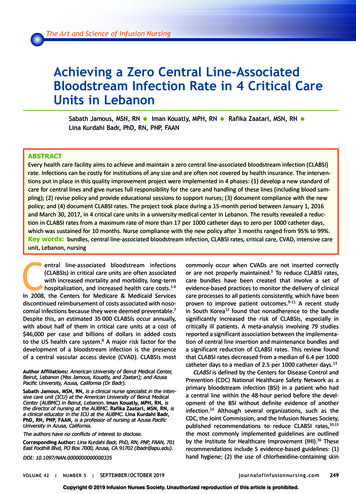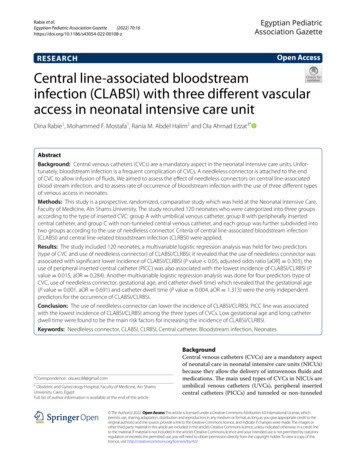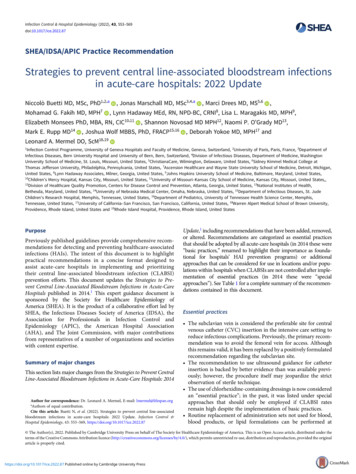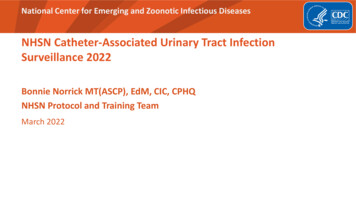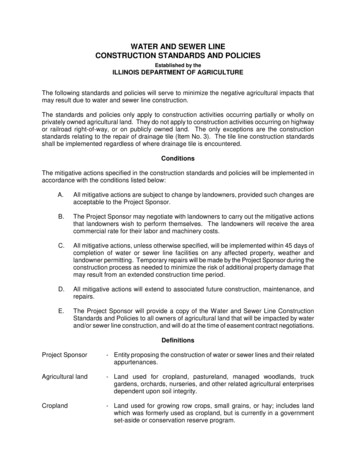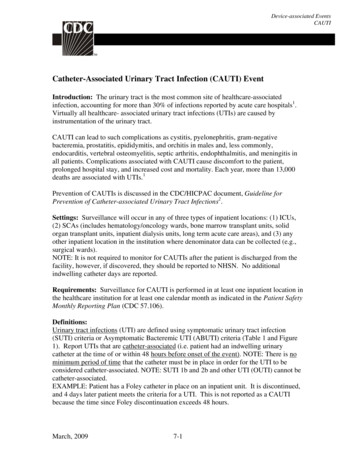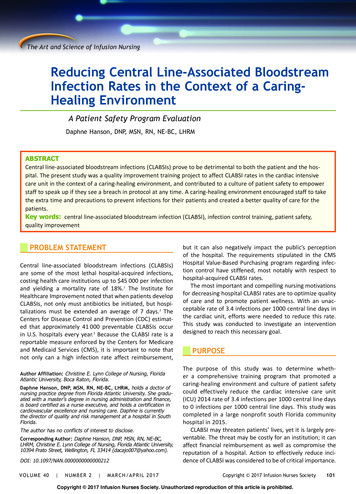
Transcription
The Art and Science of Infusion NursingReducing Central Line-Associated BloodstreamInfection Rates in the Context of a CaringHealing EnvironmentA Patient Safety Program EvaluationDaphne Hanson, DNP, MSN, RN, NE-BC, LHRMABSTRACTCentral line-associated bloodstream infections (CLABSIs) prove to be detrimental to both the patient and the hospital. The present study was a quality improvement training project to affect CLABSI rates in the cardiac intensivecare unit in the context of a caring-healing environment, and contributed to a culture of patient safety to empowerstaff to speak up if they see a breach in protocol at any time. A caring-healing environment encouraged staff to takethe extra time and precautions to prevent infections for their patients and created a better quality of care for thepatients.Key words: central line-associated bloodstream infection (CLABSI), infection control training, patient safety,quality improvementPROBLEM STATEMENTCentral line-associated bloodstream infections (CLABSIs)are some of the most lethal hospital-acquired infections,costing health care institutions up to 45 000 per infectionand yielding a mortality rate of 18%.1 The Institute forHealthcare Improvement noted that when patients developCLABSIs, not only must antibiotics be initiated, but hospitalizations must be extended an average of 7 days.2 TheCenters for Disease Control and Prevention (CDC) estimated that approximately 41 000 preventable CLABSIs occurin U.S. hospitals every year.3 Because the CLABSI rate is areportable measure enforced by the Centers for Medicareand Medicaid Services (CMS), it is important to note thatnot only can a high infection rate affect reimbursement,Author Affiliation: Christine E. Lynn College of Nursing, FloridaAtlantic University, Boca Raton, Florida.Daphne Hanson, DNP, MSN, RN, NE-BC, LHRM, holds a doctor ofnursing practice degree from Florida Atlantic University. She graduated with a master's degree in nursing administration and finance,is board certified as a nurse executive, and holds a certification incardiovascular excellence and nursing care. Daphne is currentlythe director of quality and risk management at a hospital in SouthFlorida.The author has no conflicts of interest to disclose.Corresponding Author: Daphne Hanson, DNP, MSN, RN, NE-BC,LHRM, Christine E. Lynn College of Nursing, Florida Atlantic University,10394 Prato Street, Wellington, FL 33414 (dacajo007@yahoo.com).DOI: 10.1097/NAN.0000000000000212VOLU M E 40 NUMBE R 2 M A RC H /A P RI L 2017but it can also negatively impact the public’s perceptionof the hospital. The requirements stipulated in the CMSHospital Value-Based Purchasing program regarding infection control have stiffened, most notably with respect tohospital-acquired CLABSI rates.The most important and compelling nursing motivationsfor decreasing hospital CLABSI rates are to optimize qualityof care and to promote patient wellness. With an unacceptable rate of 3.4 infections per 1000 central line days inthe cardiac unit, efforts were needed to reduce this rate.This study was conducted to investigate an interventiondesigned to reach this necessary goal.PURPOSEThe purpose of this study was to determine whether a comprehensive training program that promoted acaring-healing environment and culture of patient safetycould effectively reduce the cardiac intensive care unit(ICU) 2014 rate of 3.4 infections per 1000 central line daysto 0 infections per 1000 central line days. This study wascompleted in a large nonprofit south Florida communityhospital in 2015.CLABSI may threaten patients’ lives, yet it is largely preventable. The threat may be costly for an institution; it canaffect financial reimbursement as well as compromise thereputation of a hospital. Action to effectively reduce incidence of CLABSI was considered to be of critical importance.Copyright 2017 Infusion Nurses SocietyCopyright 2017 Infusion Nurses Society. Unauthorized reproduction of this article is prohibited.101
OPERATIONAL DEFINITIONS CLABSI: A laboratory-confirmed bloodstream infection (LCBI) where a peripherally inserted central catheter (PICC) or umbilical catheter (UC) was in place for 2 calendar days on the date of event, with day ofdevice placement being day 1; AND A PICC or UC was in place on the date of event orthe day before; If a PICC or UC was in place for 2 calendar daysand then removed, the date of event of the LCBImust be the date of discontinuation or the next day; If the patient is admitted or transferred into a facility with an implanted PICC in place, and that is thepatient’s only PICC, day of first access in an inpatient location is considered Day 1.4 CLABSI per 1000 central line days: This score is thenumber of CLABSIs among patients per 1000 centralline days. PICCs are counted each day. Each patientwith 1 or more PICCs at the time the count is performed is counted as 1 central line day.4 Pre- and postassessment tool: To identify reasons forthe high infection rate, nurses and physicians working on the unit with the highest incidence of CLABSIswere given a pre- and postassessment that had previously been tested for reliability and validity. Adult patient: Male or female individual, 18 years orolder, admitted to the inpatient intensive care. Central catheter: An intravascular catheter that terminates at or close to the heart or in 1 of the greatvessels, which is used for infusion, withdrawal ofblood, or hemodynamic monitoring (ie, peripherallyinserted central catheter, central vascular accessdevice, dialysis catheter, or arterial catheter). Great vessels for the purpose of reporting central linebloodstream infections and counting central line daysin the National Healthcare Safety Network system: Aorta Pulmonary artery Superior vena cava Inferior vena cava Brachiocephalic veins Internal jugular veins Subclavian veins External iliac veins Common iliac veins Femoral veins Bloodstream infections (BSIs): Laboratory-confirmedbloodstream infections Access: Defined as catheter placement, infusion, orwithdrawal through the catheter. Such catheters continue to be eligible for CLABSI once they are accessed untilthey are either discontinued or the day after patientdischarge. Note that the “de-access” of a port does notresult in the patient’s removal from CLABSI surveillance.102Copyright 2017 Infusion Nurses Society CLABSI rate: (number of CLABSIs identified/numberof central line days) 10004PROJECT OBJECTIVESThe most important and compelling nursing motivationsfor decreasing hospital CLABSI rates are to optimize quality of care and to promote patient wellness. Therefore,it was the purpose of this quality improvement projectto decrease the CLABSI rate by improving compliancewith protocol in the cardiac ICU within the context of acaring-healing environment, and to champion a cultureof patient safety. The goal was to increase health careworker knowledge of the cause, progression, and physical and financial toll of CLABSIs, all in a concerted effortto effectively decrease CLABSI rates. The adoption of acaring-healing environment was designed to encouragethe staff to take the necessary precautions and extra timeto prevent CLABSIs, and will serve to empower them inthe future to guide others who have breached protocol.“Caring begins with being present, open to compassion,mercy, gentleness, loving-kindness and equanimity towardand with self before one can offer compassionate care toothers.”5(pxviii) The purpose was to decrease the 2014 CLABSIrate of 3.4 infections per 1000 central line days via a comprehensive and effective training program. To accomplishthis, a pretest assessment questionnaire by which physicians and nurses in the ICU of interest were assessed withregard to their training, readiness, and ability to preventCLABSIs was administered. An evidence-based trainingcourse using Watson’s caring framework5 prepared thenurses and physicians for a higher quality of patient care. Aposttest questionnaire was administered after the trainingwas implemented. The CLABSI rate was collected by adherence to CDC guidelines of (number of CLABSIs identified/number of central line days) 1000.LITERATURE REVIEW AND SYNTHESISSimilar research studies have undergone similar programsat their hospitals in an effort to decrease CLABSI rates.Effective training and teaching are essential when it comesto proper infection control and nursing protocols and procedures. Parra et al6 prove that evidence-based training iseffective in reducing the incidence of CLABSIs in the ICU.The study also used a pre- and posttest as an outcomemeasurement for nursing knowledge and the validity ofthe training provided. The pre- and posttest measurementof health care worker knowledge was a goal to replicate inthis project.Adriana et al7 also analyzed how a training programwould impact CLABSI rates in a surgical ICU with the inclusion of the infection control department. The interactivetraining program and infection control personnel roundingJournal of Infusion NursingCopyright 2017 Infusion Nurses Society. Unauthorized reproduction of this article is prohibited.
sustained long-term decreases in the unit’s CLABSI rate.The presence and support of a physician epidemiologist hasalso proven to reduce CLABSI hospital rates.8 The successshows the importance of working together between theinfection prevention team and ICU health care workers forachieving the goal of reducing infections in the ICU.The Leapfrog Group, which benchmarked hospitalswith the lowest rates for CLABSI prevention, used a qualitative observational study to show how hospitals reducedtheir CLABSI rates. The study found that these points—hand hygiene, maximal sterile barrier precautions, chlorhexidine skin antisepsis, appropriate insertion site selections, and prompt removal of unnecessary catheters—allproved to reduce CLABSI rates in the target hospitals theyreviewed.1Render et al9 noted that the U.S. Department of VeteransAffairs hospital system quality infrastructure successfully reduced its CLABSI rates when it included the following: engaging multiple levels of leadership, support of themicrosystem, measurement, benchmarking, tools, policies/procedure samples, training, interdependence with daily goalsheets, performance results, and information technology.Bianco et al10 found that a knowledge deficit in handhygiene was contributing to higher CLABSI rates. Health careworkers’ hands represent the main route of transmission ofhospital pathogens, and hand hygiene is the most basicand essential intervention for reducing hospital-acquiredinfections. The study showed that written policies, formaltraining in infection control and hand hygiene, and lengthof experience working as a nurse all contributed to a reduction of CLABSI.Guerin et al11 assessed the effectiveness of daily inspection of the central catheter, site care if the dressing waswet, soiled, or had not been changed for 7 days; documentation for ongoing need of the catheter; proper applicationof chlorohexidine gluconate sponge at the insertion site;performance of hand hygiene before handling the intravenous (IV) system; and alcohol scrub to the infusion hubfor 15 seconds before each entry. The study demonstratedthat implementation of a central catheter quality assessment routine was associated with a significant reduction inCLABSIs. The study states that with staff training and reinforcement of proper central catheter care after insertion,along with careful cleaning of the hub before each access,staff can reduce the incidence of infection on inpatientunits.The theme throughout the research articles on CLABSIprevention is the importance of an informed health carepractitioner. Health care personnel should understandthe appropriate care and maintenance needed to preventCLABSI infection after central catheter insertion as well asthe proper techniques in postinsertion care.12 The researchof Zaiton and Taha12 assessed the effect of implementingcentral line bundles to minimize the rate of CLABSIs amongICU patients. The recommendation that arose was thatVOLUME 40 NUMBER 2 MARCH/APRIL 2017nursing needs to be empowered to enforce the use of central line bundles to be sure that all processes related to central catheter placement are executed for each placement.This study was aligned with this project of creating a patientsafety environment to empower staff to voice their concernif they see a breach in protocol at any time.CONCEPTUAL FRAMEWORKThe theoretical framework chosen was Jean Watson’sTheory of Human Caring. The theory encompasses thepractice of loving-kindness and equanimity, being authentically present by enabling deep belief of other, cultivatingone’s own spiritual practice toward wholeness, being in thecaring-healing environment, and allowing miracles to occur.5Being in the caring-healing environment allowed the nurseempowerment to speak up if she or he viewed a breach inprotocol. The prevention of a bloodstream infection reliesvery heavily on the nurse’s authentic presence with thepatient and being cognizant of taking the extra steps necessary to prevent a bloodstream infection from occurring.The theory also harbors a moral commitment to protect andenhance human dignity by respecting the patient’s needs,which is very important with ICU patients. The projectcreated a caring-healing environment in which the nurses,physicians, and doctors were authentically present with thepatient, which enhanced human dignity by providing a safeenvironment of care.PROJECT DESCRIPTIONSteps in the ProcessNurses and physicians working on the unit with the highest incidence of CLABSIs were given a pretest to identifycauses for the high infection rate. On evaluation of the dataobtained from the pretest, nursing leadership assessed the2014 infection control policies. An evidence-based training course using Watson’s caring framework prepared thenurses and physicians for a higher quality of patient care.Evidenced-based training was conducted and disseminatedto physician and nurse health care workers in the cardiacICU during the month of May.After full instructions were given, the unit was placedunder observation for a 3-month period. At the completionof this period, the posttest was administered. The posttestwas used to quantify a change in health care worker knowledge, with an improvement in scores denoting effectivetraining. Training effectiveness was also determined by adecrease in the CLABSI rate. The control for the study wasthe CLABSI rate recorded on the same unit the previousyear. Thus, the study’s CLABSI rates were compared withthe control group to assess whether a statistically significant improvement in rates existed.Copyright 2017 Infusion Nurses SocietyCopyright 2017 Infusion Nurses Society. Unauthorized reproduction of this article is prohibited.103
Research DesignThis study was conducted using an exploratory sequentialmixed method design. Qualitative data were collected andused to develop an educational intervention. A pretest/posttest, preexperimental design was used to measurechanges in knowledge and practice and to determinethe effectiveness of an educational intervention. Lastly, aquasi-experimental design was used to compare the previousyear’s infection rate to the infection rates post intervention.A quasi-experimental approach was used to conduct thisstudy by combining the pretest/posttest assessment questionnaire with a control group to evaluate the educationalintervention. The data were then analyzed using inferentialstatistics (χ2 tests) because of their ability to allow conclusionsto be drawn about the relationships between compliancerates before and after the educational intervention took place.Statistical TreatmentThe statistical method chosen for this study was the χ2.Plichta and Kelvin described the χ2 statistical method as a“nonparametric test used to assess whether a statisticallysignificant association exists between the rows and columnsin a cross-tabulation (contingency) table.”13(p456) This methodwas chosen because the CLABSI rate in the cardiac ICU during2014 was compared with the rate in 2015 after a comprehensive training program that was given to all of the treatmentpopulation, with the CLABSI rate of the same unit during theprevious year when no training program was given. The overallobjective was to decrease the number of infections as a resultof the educational intervention. A χ2 was completed for eachquestion in the pretest/posttest questionnaire to evaluate thestatistical significance of each response.ParticipantsThe study participants for this research were divided into2 distinct categories: treatment population and outcomepopulation. The total study participants in the treatment population consisted of the 150 health care providers who hadpatient access to the cardiac ICU and who had participatedin the mandatory comprehensive training program regardingthe proper care technique of PICCs. The pretest/posttest toolwas an anonymous questionnaire given to all 150 participants.Participants consisted of both physicians and registered nursesworking in the cardiac ICU during the study period. The sample from this research came from data collected on the totalCLABSI rate on the cardiac ICU in 2015 and was compared withthe total CLABSI rate from the same unit recorded the previous year. Criteria for sample eligibility in CLABSI outcome dataincluded the following: adult patients in the cardiac ICU whowere 18 years of age or older, had current inpatient status, andhad a PICC inserted during their hospital stay.Sampling ProceduresSampling was conducted in a purposive manner. The data inthis study stemmed from a very specific group of respondents:the ICU nursing and physician staff members who had inserted104Copyright 2017 Infusion Nurses Societyand maintained PICCs on the hospital’s ICU with the highestCLABSI rates. Information was gained from only those individuals working on this particular unit. Every individual on theunit involved in insertion or maintenance of PICCs was placedin the study. The sampling procedure specific to the patientpopulation for the CLABSI outcome data was as follows: everyadult patient with a PICC from the cardiac ICU being studiedwas included as long as the PICC was not present before thatindividual’s arrival.Educational InterventionThe evidence-based training course was drawn from themost current CDC definitions of CLABSI, guidelines on PICCmaintenance as well as from the hospital’s infection controlprotocols and procedures. The education was developed andcustomized after the responses in the pretest questionnairewere completed in an effort to standardize the learningexperience for the nurses and physicians. The learning beganwith the basic definition of what a PICC is and how the infection cultivates in a human body on insertion without correctsterile techniques and nursing maintenance on a day-to-daybasis. The education focused on the importance of CLABSIrates to nursing as a publicly reported measure, as well ascost to the hospital and, most important, the harm it does tothe patient. The physicians and nurses were then shown theirindividual unit’s CLABSI rate when compared with the rest ofthe hospital as well as nationally. Patient acuity risk factorswere discussed such as site of insertion (groin or jugular sitepose a higher risk), multiple lumen catheters (the more thelumens, the more risk for infection), or infection elsewheresuch as urinary tract infection or wound. The importance ofhand hygiene, scrubbing the hub with a juicing motion for 5to 15 seconds before access and having a free flowing bloodreturn on catheter aspiration was also mentioned in the presentation, which are the current CDC guidelines for PICC care.Daily assessment of the PICC was reviewed, such as usingaseptic techniques for access, inspecting the PICC site forsigns of infection, always using a 10-mL syringe to access thePICC, flushing each lumen routinely every 12-hour nursingshift to maintain patency, and reducing a chance of embolismin the catheter. The electronic medical record documentationfor PICC insertion, education, and maintenance was alsoreviewed in the class as well as teaching on empowermentto stop the insertion if you see a break in sterile procedure.A “Bad Habits” slide was presented on observed behaviorsof nurses in the hospital when they did not have the correctsupplies or were in a rush. The behavior consequences wereexplained to the physicians and nurses as detrimental topatients (Appendix 1). Lastly a caring-healing environmentslide was discussed on the importance of patient safety andquality.In addition, a focus was placed on both cultivating acaring-healing environment and on the critical importance ofpatient safety. The training was conducted by the hospital’seducation department within the unit being studied. The education department gave oral instructions to each individual andJournal of Infusion NursingCopyright 2017 Infusion Nurses Society. Unauthorized reproduction of this article is prohibited.
conducted group-oriented presentations. The training occurredwith biweekly educational sessions scheduled at differenttimes for day- and night-shift health care workers.Data CollectionCLABSI rate data were collected during the months of Junethrough August, and the posttest was administered inSeptember. Analysis of the data was completed when allthe posttests were collected. The methods of evaluationwere to demonstrate increased knowledge of CLABSI ratesthrough the training competence tool.The CLABSI rate surveillance was monitored with the assistance of the infection control coordinator at the hospital, whofollowed CDC guidelines for identification of an infection in aPICC. A pre- and postquestionnaire, evaluated for its reliabilityand validity, was used to help evaluate both the training effectiveness and the adoption of an improved culture of patientsafety. The project outcomes measured were CLABSI rates,training effectiveness, and the culture of patient safety onthe hospital unit. The data were paired with daily rounds ofPICCs by the infection control team. The pre- and posttrainingassessment tool data were analyzed using comparative χ2statistics. The data were trended to see whether an increasein CLABSI knowledge was directly correlated to a decrease inCLABSI rates.InstrumentThe pre- and postquestionnaire, used in a previous CLABSIperformance assessment and improvement project(Appendix 2), had been tested for reliability and validity,and was selected to identify reasons for the high infectionrate. Ramos and Beriones14 tested the tool for usability atthe Methodist Hospital in Houston, Texas. This tool wascreated using the plan-do-check-act process model, whichhad its underpinnings from the Johns Hopkins’ comprehensive unit-based safety and translating evidence into practice conceptual model. The final 3 questions, designed toassess patient safety, were from the Agency for HealthcareResearch and Quality’s Hospital survey on patient safety.15RESULTSA data analysis was completed by providing binary codesfor the pre- and posttest answers for each response posedon the questionnaire. To determine whether a statisticallysignificant change occurred, a χ2 analysis was completed foreach item. According to the results, there were no significantassociations noted between the educational interventionand the staff’s compliance with labeling the PICC dressings,χ2(1,150) 0.207, P .324, changing soiled or loose dressings, changing the transparent dressing weekly, scrubbingthe hub, or changing tubing per protocol, all of which reflectthe following data, χ2(1,150) 1.007, P .158. Though notstatistically significant, it is important to note that for each ofthese activities, staff compliance actually decreased. Insteadof comparing the total scale score it was most beneficial toVOLUME 40 NUMBER 2 MARCH/APRIL 2017investigate each item to help evaluate what areas the trainingand checklist were improving the most.Some significant changes were noted, however.According to the Pearson χ2 analysis, there was a significant association between educational intervention andan increase in the frequency in which the needlelessaccess ports were changed χ2(1,150) 3.061, P .04.Additionally, there was a significant association betweeneducational intervention and a change in the participants’perception of whether or not mistakes were held againstthem, χ2(1, 150) 31.452, P .001, suggesting that thisperception had decreased. In support of this finding, theposttest indicated an improved outlook regarding theparticipants’ ability to speak up when an action was not inalignment with the facility protocol or with best practice,χ2(1, 150) 16.667, P .001. Finally, and most important,there was a statistically significant decline in the occurrenceof CLABSI following the intervention, χ2(1,2000) 5.496,P .009, when compared with the CLABSI rate from thesame unit the year before.Care barriers had 3 subsections: lack of time, lack ofsupplies, and lack of knowledge regarding standard practiceand protocol. In general, there was a statistically significantchange among all the perceived barriers, χ2(2, N 150) 32.557, P .001; however, staff increasingly identified lackof supplies as the primary obstacle in providing appropriatecare. This may be the result of an increase in knowledgeregarding which supplies are considered appropriate forproper PICC care, or it may be attributable to an unknownfactor. The increase in the identification that a lack of supplies affects care, and the decrease in compliance with certain care techniques, are both important issues that could beconsidered subjects for further exploration.Overall, the data represent a significant improvement incompliance with many factors related to lowering CLABSIrates. The data also support a significant decrease in theoccurrence of PICC infections, as evidenced by the finaldata reflecting a decrease from the 3.4 infections per 1000in 2014 to 1.2 per 1000 central line days infection rate in2015 (Appendix 3). There are multiple points that requirefurther inquiry and could, therefore, be the focus of futureresearch. Qualitative data and participant identifiers mayhave clarified the rationale for the unexpected changes.HYPOTHESES AND RESULTSThe research hypothesis—that evidence-based CLABSItraining, in the context of a caring-healing environment withan emphasis on patient safety, would decrease ICU CLABSIrates in high-risk adults when compared with the CLABSIrates from the same month in the previous year—wastested and proven to be true. The results of this study suggested that implementation of a CLABSI training program,which focused on CLABSI reduction and patient safety,would result in an increase in each participant’s knowledgeCopyright 2017 Infusion Nurses SocietyCopyright 2017 Infusion Nurses Society. Unauthorized reproduction of this article is prohibited.105
of policies and procedures, and thus in a higher degree ofcompliance to protocol. The evidence indicated that nursesand physicians not only gained a higher level of understanding of CLABSI through training, but that their ability todetect CLABSI early had improved. Readministration of thequestionnaire not only evaluated knowledge gained, butexposed the facility’s need for ongoing educational updatesand daily infection control rounds.There was no significant association between educationalinterventions and whether the staff label the PICC dressing,change soiled or loose dressings, or scrub the hubs. Therewas, however, a significant association between educationalintervention and an increase in the frequency with whichthe needleless access ports were changed. There was alsoa significant association between educational interventiongrounded in caring and the perception of whether or not mistakes are held against staff members. After the intervention,the staff felt significantly more confident in their ability tospeak up when they observed breaches in PICC care.DISCUSSIONThe goal to decrease the CLABSI rate to fewer than 3.4 infections per 1000 central line days with an effective trainingprogram was met. The repercussions of CLABSI are formidable. CLABSI not only threatens the life of the afflicted patient,but it can also destroy a hospital’s reputation and financialstability. The CDC has a zero tolerance for CLABSI, and theCMS has mandated that no hospital will be reimbursed forthe care of a patient who develops CLABSI. In a concertedeffort to lower the incidence of CLABSI from 3.4 infectionsper 1000 central line days in the hospital’s cardiac ICU, thisstudy has shown that an educational intervention groundedin caring could effectively reduce this number, while simultaneously building a culture of patient safety and staff cooperation. The implications of this study are far-reaching and canbe viewed as a template for hospitals everywhere. It has alsoopened the door for further exploration into the fine-tuneddeterminants of CLABSI. Most important, however, in itsjourney toward eradication of CLABSI, this study has madean important and noble effort to prove that education, inthe spirit of a caring-healing milieu, can effectively facilitateany hospital’s aspiration to reach for that previously elusive,albeit critically needed, zero.CONCLUSIONThe unacceptable 2014 CLABSI rate at the cardiac ICU was3.4 infections per 1000 central line days. By implementinga comprehensive CLABSI-reducing training program thatembraced a caring-healing philosophy, the hospital wasable to successfully lower its 2015 rate to 1.2 infectionsper 1000 central line days during the observation period.This downward trajectory of the CLABSI rates from 2014106Copyright 2017 Infusion Nurses Societyto 2015 proved to be a positive quality indicator thatevidence-based training can help prevent CLABSI. By cultivating a culture of zero tolerance for CLABSI, the hospitalhas reduced morbidity, saved lives, and control
nursing practice degree from Florida Atlantic University. She gradu-ated with a master's degree in nursing administration and finance, is board certified as a nurse executive, and holds a certification in cardiovascular excellence and nursing care. Daphne is currently the director of quality and risk management at a hospital in South Florida.


